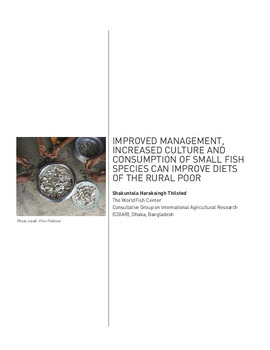Improved management, increased culture and consumption of small fish species can improve diets of the rural poor

Citation
Thilsted, S.H. (2012). Improved management, increased culture and consumption of small fish species can improve diets of the rural poor. p. 176-181. In: Burlingame, B. ; Dernini, S. (eds.) Sustainable diets and biodiversity: Directions and solutions for policy, research and action. FAO and Bioversity International, Rome
In many low-income countries with water resources, small fish species are important for the livelihoods, nutrition and income of the rural poor. The small size of fish favours frequent consumption by and nutrition of the rural poor, as these fish are captured, sold and bought in small quantities; used both raw and processed in traditional dishes; and are nutrient-rich. All small fish species are a rich source of animal protein, and – as they are eaten whole – have a very high content of bioavailable calcium. Some are rich in vitamin A, iron, zinc and essential fats. Measures to improve management and increase culture and consumption of small fish include community-based management of common water bodies; culture of small fish in ponds and rice fields; use of small marine fish for direct human consumption, especially in vulnerable population groups; and improved handling, transportation, processing – especially drying – and market chains to reduce loss and increase accessibility, especially in hard to reach population groups. Recent integrated initiatives such as Scaling Up Nutrition (SUN) Framework and Roadmap: 1,000 Days Global Effort, focusing on the linkages between agriculture and nutrition give good opportunities for promoting improved management, and increased culture and consumption of small fish species.
Permalink
Date Available
Type
Language